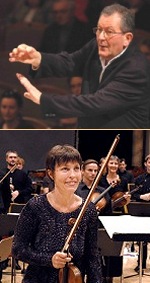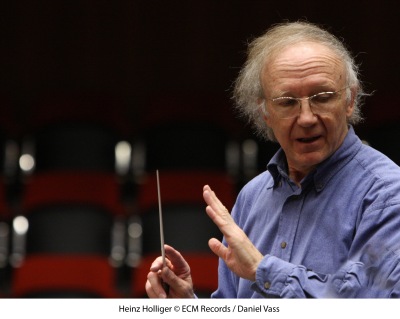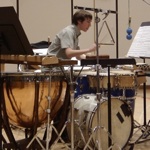 The Orchestra of the S.E.M. Ensemble, founded and directed by Petr Kotik, joins forces with the acclaimed FLUX Quartet and the international chamber orchestra Ostravská banda for an evening of adventurous music: Wednesday, May 06, 2009 8:00 PM, Alice Tully Hall, Starr Theater. Tickets are a steal, only $15 for a real wealth of music.
The Orchestra of the S.E.M. Ensemble, founded and directed by Petr Kotik, joins forces with the acclaimed FLUX Quartet and the international chamber orchestra Ostravská banda for an evening of adventurous music: Wednesday, May 06, 2009 8:00 PM, Alice Tully Hall, Starr Theater. Tickets are a steal, only $15 for a real wealth of music.
Highlights include three new pieces by self-taught composers: the premiere of Christian Wolff’s Trio for Robert Ashley (2009), performed by members of the Flux Quartet; the American premiere of Sicilian-born composer Salvatore Sciarrino’s Vento D’ombra (2005), performed by The Orchestra of the S.E.M. Ensemble; and the premiere of Petr Kotik’s String Quartet No. 1, Erinnerungen an Jan (2007–09), performed by the Flux Quartet. The program also features renowned Belgian pianist Daan Vandewalle in Elliott Carter’s Dialogues for Piano and Orchestra (2003), and award-winning Czech violinist Hana Kotková in György Ligeti’s Concerto for Violin and Orchestra (1990–92) — both making their debuts at Alice Tully Hall. Petr Kotik conducts The Orchestra of the S.E.M. Ensemble as well as Ostravská banda.
Kotik writes: “To me, Ligeti’s Concerto for Violin and Orchestra always sounded strange, as if something were out of place. When I was asked by the Prague Spring festival to conduct the piece last May, I worked to solve the puzzle, but to no avail. Then moments before the start of our first rehearsal with Hana Kotková and the Ostravská banda, I suddenly got an idea. I walked up to Hana and said, ‘You’ve got to play the piece like a gypsy would. That’s how it should sound, I think.’ She looked at me and immediately understood what I meant. Hana grew up in a family that made folk music for generations. She has participated in performances since the age of four, often alongside fiddlers and cimbalom virtuosos, who were often Romani. She comes from the Silesian part of Moravia, right next to the Carpathian region from which most of Ligeti’s melodies come. No one can understand this music better than Hana. It was a thrill to conduct Ligeti Concerto with her as the soloist and I am delighted that she was able to accept this appearance at Alice Tully Hall.
Since the premiere of John Cage’s complete Atlas Eclipticalis by then newly formed The Orchestra of the S.E.M. Ensemble (86 musicians) at Carnegie Hall in 1992, S.E.M. has made a significant contribution to new music here in the U.S. and in Europe. And with Ostravská banda, founded at Ostrava Days 2005, a group which combines musicians from both sides of the Atlantic was a natural thing (Ostrava Days is a new music institute and festival taking place every other year at Ostrava in the Czech Republic). Ostravská banda consists of young musicians from the Czech Republic, Slovakia, Germany, Hungary, Holland and the United States, who are focused on the performance of new music. It is not necessary to introduce the New York-based FLUX Quartet. At Alice Tully, they will be performing the pieces by Wolff and Kotik. In January, when I asked Christian for a piece for this concert, he decided to compose Trio for Robert Ashley as there was my new string quartet on the program. He had recently attended Robert Ashley’s opera Dust and was very moved by the work. The title reflects his admiration for Ashley’s music, its rhythms and structural movements.”
— If you can’t make it, S21’s own Christian Carey will be there and will be filing a report post-concert.



 We’ve reached the final concert of
We’ve reached the final concert of  Apropos this Wednesday’s Michael Gordon Trance performance
Apropos this Wednesday’s Michael Gordon Trance performance  Sunday afternoon was the final concert provided by Esa-Pekka Salonen as Music Director of the Los Angeles Philharmonic. He has consistently said that he’ll be back with us on a regular basis, but before the start of the concert, the administrative management and the Board came on stage to announce to us the Salonen now has the title of Conductor Laureate and will return on a regular and “significant” basis in the future. The nature of the continuing role was not announced, but it is consistent with how well the Phil (and Salonen) have handled this transition that the details on the role of the future would wait to be announced until after Dudamel is on board and present.
Sunday afternoon was the final concert provided by Esa-Pekka Salonen as Music Director of the Los Angeles Philharmonic. He has consistently said that he’ll be back with us on a regular basis, but before the start of the concert, the administrative management and the Board came on stage to announce to us the Salonen now has the title of Conductor Laureate and will return on a regular and “significant” basis in the future. The nature of the continuing role was not announced, but it is consistent with how well the Phil (and Salonen) have handled this transition that the details on the role of the future would wait to be announced until after Dudamel is on board and present. It’s hard to imagine a percussionist that you would want to perform your music more than
It’s hard to imagine a percussionist that you would want to perform your music more than